At ASID, we are constantly inspired by the power design has to improve the human experience and transform environments. One of the most impactful ways to do this is through post-occupancy research. Post-occupancy research demonstrates the impact and value that thoughtful design (and designers) bring to the table. This research is not only beneficial for designers to understand the impact of their work but also for occupants to understand how the built environment affects them.
Conducting and studying post-occupancy research in workplaces helps pave the way for organizations and companies to recognize the outstanding benefits of human-centered design. Our recent study at ASID Headquarters in Washington, D.C., provides vital insight into how our employees work best and gives us direction on how to help the ASID HQ continue to evolve. We are excited to finally share these findings with members of the industry and to showcase the sweeping benefits of post-occupancy research in promoting health, wellness, productivity, and innovation in the workplace.
In May 2016, our corporate headquarters was transformed into a living laboratory for the design community. It became the first space in the world to achieve both Platinum certification for the WELL Building Standard WELL v1 and LEED under the LEED ID+C rating system—the highest recognition awarded by the U.S. Green Building Council (USGBC) and the International WELL Building Institute (IWBI). Our office space, designed by Perkins+Will, incorporates the most innovative health and wellness design features and has sustainability as a central philosophy.
Partnering with Cornell University, Delos, and the Innovative Workplace Institute, the ASID Research department conducted a comprehensive pre- and post-occupancy study of our new headquarters, examining the impact of innovative workplace design. The outcome was greater than we had expected.
some key highlights from the asid hq study include:
◗ Design improves environmental quality:
Although ASID HQ is already maintained as a healthy and sustainable office as demonstrated by both LEED Platinum (v.3) and WELL Platinum (v.1) certifications, our post-occupancy research provided greater insight. Office metrics indicate a 158-percent reduction in CO2 levels, a 50-percent reduction in loudness, and a 63-percent improvement in brightness. ASID employees reported a 110-percent increase in air quality satisfaction, a 92-percent increase in acoustical quality satisfaction, and 25 percent of employees attributed ASID HQ’s circadian lighting to enhanced sleep quality.
◗ Design impacts the experience: Office features like unassigned seating increased visual privacy, and overall design elements (lighting, acoustics, color, texture, etc.) all had a positive effect on our employees’ social environment and experience. It was also noted that our office design plays a role in facilitating communication among employees (a 42-percent increase from the previous office) and in supporting the sharing and exchanging of ideas (a 44-percent increase).
◗ Design helps achieve results: ASID HQ’s
innovative design has positively affected the health and well-being of our employees while boosting overall efficiency. Incorporating sit-stand workstations, fitness center access, healthy snacks, filtered water and air, common rooms, and a wellness room have resulted in a 2-percent improvement in physical health scores within a year of occupying the 15th Street office. Also, ASID employees feel they are working at 90 percent of their possible job performance—a 16-percent increase compared to the previous year.
◗ Design lives on: The agility of ASID HQ is
fundamental to our success. With adjustable workstations, regularly alternating artwork, modifiable spaces that can switch from a conference room to an interactive hub, and a wide availability of varying work environments, ASID HQ’s flexibility allows for future growth and continuing research in this living laboratory.
Our research also pointed out areas for improvement—a significant benefit of post-occupancy research. This data has already started to improve ASID HQ. We’ve taken note of employees’ needs for “recharge spaces” and “heads-down spaces” that minimize any disturbance or disruption and now have the ability to correct errors we otherwise may not have known about.
As our living laboratory continues to evolve with the needs of employees, we will continue to share the story of how design impacts our lives. Visit our website, asid.org, to share stories and projects that have succeeded in applying research to maximize human-centric design.
Susan Chung, Ph.D., focuses on the impact of design research. As senior research associate at ASID, she connects design with research to improve human experiences in the interior environment, translates research into applicable design implications, and conducts research projects that create meaningful positive impacts.
